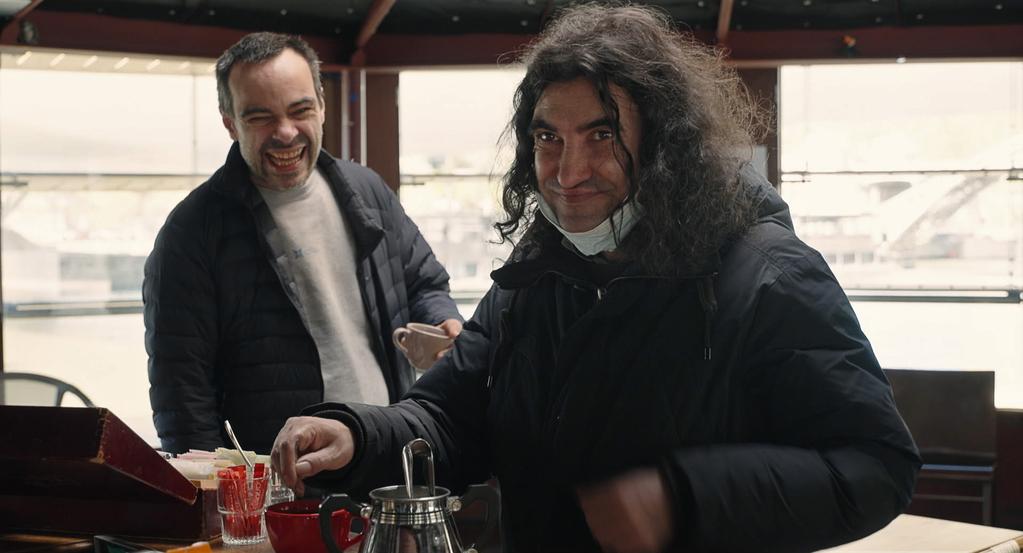By Hamed Soleimanzadeh.
By bringing attention to the challenges of the surrounding world, exotic protest cinema encourages audiences to take responsibility against the injustices and inefficiencies.”
The concept of political-cultural exoticism in protest cinema refers to the presentation and understanding of ethnic, national, and regional cultures and policies in films whose nature and identity are generally alien to a large audience.
One example, On the Adamant, directed by Nicolas Philibert, shows a different side of the day center Adamant, located in the center of Paris. It is located on the right bank of the Seine, near the Charles de Gaulle Bridge. This unique center houses adults with mental disorders. With the help of treatment workshops and psychological and social rehabilitation support, the center strives to help patients regain their place in daily life.
Adamant’s team includes psychiatrists, psychologists, nurses, occupational therapists, specialist trainers, psychomotor specialists, care coordinators, hospital staff, artists, and art therapists. Through cinema, music, painting, literature, and handicrafts, the staff of this center tries to treat patients through art. An annual film festival is held at Adamant where the patients choose the films and discuss them. The curious presence of the camera and the effort to introduce the creative thinking of the characters in the Adamant, highlights the use of scenes with the effects and function of art therapy, and the meaningful depiction of the floating location in connection with the central idea, are the special and prominent points of this film.

On the Adamant contains political, social, cultural, and philosophical sarcasm in hidden layers. From a political-cultural point of view, all the treatment staff of the Adamant are trying to influence the French government and the rulers of the health sector by their actions to support this sort of respectful and dignified approach that acknowledges the patient as a human being. By diversifying the services and spending time with patients, the staff of the Adamant address the need to revise French treatment policies.
The opening scene of the film, in which the patient performs a pop song with a trembling but passionate body and face, refers to projecting worries, concerns, and even mental complexes through art. It shows how art can be more effective in treating patients than medicine. These indirect taunts aim at the huge pharmaceutical companies and business reps of the world who sometimes seek mass production at the expense of human ethics, values, and identity. Ontological and philosophical attitudes are reflected in the words of the patients talking to the camera. A patient who enjoys cinema, for example, says to other patients: “You have actors here who don’t realize they are actors. It’s not medical. They are actors without realizing it.”
An exotic, non-traditional space is implied by the film’s ironic location, which is both floating and anchored, both familiar and strange. Meanwhile, the shelter in the center of the city where the film takes place is a sign of the patient’s unconscious world; a world at once floating and restless, yet still and static at the same time. In spite of severe mental health issues, these patients express their creativity through art. As a result of such a situation, the characters survive by creating art and removing themselves from the world around them, pulling against the strong anchor holding them back from straying too far from it.
A great deal of the drama in Tótem’s narration takes place inside the house alone, a locale masterfully connected between different spaces and places. The characters are aware of private conversations, they recognize each other’s tones, and it’s as if they have no secrets between them [creating a]n impressive collage of human relationships.”
Tótem, directed by Lila Avilés serves as an important example of exotic magic realism cinema. Sol, a seven-year-old girl, goes to her grandfather’s house, where her aunts are preparing a surprise birthday party for her father, which is also considered a farewell ceremony. Toward the end of the story, an exotic, strange, and chaotic atmosphere dominates and breaks apart the family. A labyrinthine space, winding corridors, and many rooms in the grandfather’s house make the place reminiscent of those in magical realism literature, especially that of Gabriel García Márquez. It is important to note that a great deal of the drama in Tótem’s narration takes place inside the house alone, a locale masterfully connected between different spaces and places. The characters are aware of private conversations, they recognize each other’s tones, and it’s as if they have no secrets between them. An impressive collage of human relationships is created in this film. From a single human figure, pieces of each character are mounted on another character.
The title of the film reminds the audience of the keyword totem, which draws the audience into the story from the beginning, wondering who or what the totem is. Is the totem a sacred object, a character, or something else? Tótem depicts a life where everything seems normal, but there is a magical or unnatural element to it by defining strange cause-effect relationships. An example of this is the scene in which a woman waving a burning stick around and continuously belching attempts to remove bad karma from the house.
Women and femininity have been given special attention in the film’s characterization. Sol’s two aunts plan a birthday party and decide on all the details. Through close-ups of these characters, the audience gets to know Sol’s relatives better, but audiences are also emotionally and physiologically connected to the strange characters of the film. As the film’s scenes are mostly short, and the editing attempts to break the main narration line, the viewer gets closer and closer to the truth hidden in the drama by following the subplots. With a focus on a poverty and its sufferings, Tótem follows the themes of magical realism stories and shows an anti-imperialist perspective. Sol’s extended family has a poor social class as shown by the failure to pay her father’s nurse on time, as well as fundraising for treatment at the final party.
One long scene reveals Sol sitting in front of the cake and looking at the candles, and we wait to see if her father will come to blow out the candles and make a wish. Having waited so long for her father, the audience understands well that his absence means loss. Here we realize that the totem is Sol itself. Her family gathers around her so that she can be protected from destruction, giving her an appearance of purity and uniqueness.
A variety of film critics lauded Makoto Shinkai’s animated film Suzume, which premiered in competition at the Berlinale. It is about a girl named Suzumi who meets a mysterious young man named Sota who is looking for a door at the beginning of the film. Among the rubble, Suzumi finds a dilapidated but upright door. It is as if the door is protected from all disasters. When Suzumi tries to open the door, a terrible force is released and wants to destroy everything nearby.
Suzume successfully combines the natural and spiritual worlds, using epic storytelling akin to Japanese anime, especially Hayao Miyazaki’s work. One of Shinkai’s artistic features is the combination of shadows and light. By balancing images of the real with fantasy worlds, he creates an exotic atmosphere of post-apocalyptic conditions for the audience. It has been very successful from this point of view because the film incorporates its fantasy world more and more into the real world through its photo framing.
In terms of content, Suzume utilizes a theme that is meaningfully connected to Japanese history and people’s general fear of earthquakes causing total destruction. Because of its organic connection with the collective unconscious of the Japanese people, the film’s theme resonates with the global audience because they all feel the same anxiety.




Although Suzume‘s script follows the pattern of the hero’s journey, there are many sub-stories that expand upon it. As the story’s protagonist is a girl who can become Japan’s savior from a demonic force, the film’s feminist approach is evident from its theme. Meanwhile, Suzume emphasizes the principle of preserving heritage in the modern world and values the things that have been lost. Empty villages, a closed middle school, and an abandoned amusement park depict the rediscovery of life in environments where people once lived. Rather than dwell on destruction, the film seeks to restore our responsibility to rebuild the lost world and care for our current environment.
A highlight of the film is the transformation of Sota into a chair who has to hunt down a cat with an evil spirit named Daijin. As a result of this unique defamiliarization and giving the chair a human identity, Suzume has reached the level of the best Japanese animation work in recent years. Through elements such as integration and replacement, the fantasy characterization of the film can serve as an allegory for changing our nature while preserving our identity and spirit.
Among the other elements that have contributed to the rhythm and dynamics of the film’s subsequent scenes, especially the chase scenes, is its music. In this film, the music is successful in creating tension and conflict between the audience and the incident. Suzume has a certain cultural exoticism because of its anthropomorphic characters, incredible battles, and hopeful core, making it appealing to a wide range of audiences.
The Survival of Kindness, directed by Rolf de Heer, is another experimental, exotic, and protest film this year. It tells the story of a black woman imprisoned in a cage in the middle of the desert to die. She freed herself from prison with a commendable effort, but along the way, she faces obstacles reminiscent of bigger prisons. Eventually, she returns to her cage and remains silent.
This film metaphorically criticizes world powers and the way they are managed by dealing with racial conflicts, colonialism, and exploitation. There has been a certain process of colonization on every continent, ethnicity and tribe, but it cannot be denied that heavy colonialism passed over people who weren’t white enough, and that is why the black woman in The Survival of Kindness represents all those who have endured violence throughout history in different forms. Another theme of the film is the destruction of ancient cultures and ecosystems in the name of progress.
By combining eye-catching images with a mysterious and wordless story, the audience is drawn into an ecstasy, in which making meaning is postponed, and finally, they become something other than what they are. French filmmaker and anthropologist Jean Roche called such a film Cinema-Ecstasy (Andrew, 2010, p.32). In The Survival of Kindness, ecstasy is like rolling into a magical labyrinth with no guarantee of return, and in this sense, it is philosophically political and culturally exotic.
The Survival of Kindness evokes a feeling of the uncanny. Freudian psychoanalysis defines the uncanny as a feeling that occurs when faced with some objects or situations that are familiar, but at the same time convey a strange sense of alienation to the viewer or subject, and at the same time, this feeling is scary, but it also has a kind of hidden attraction (Schultz, 2016, p.93). There is still kindness left? This question repeats itself throughout the film like a conceptual motif. This is the beginning of an allegorical exploration of spectatorship.
From a narration perspective, The Survival of Kindness has a core that emerges in the middle and in the course of expansion. Despite its non-narration nature, the scenes of this film are like an art installation that can be rearranged in any order and still be effective. The audience can actively participate in the experience of suffering by using this special artistic technique instead of judging historical crimes. It emphasizes the idea of discontinuity and the sequence of events in the narration by not using a single language and having some characters speak in unknown languages.
From its executive approach, the film’s idea, which is deep and reliant on a critical situation, is combined with static compositions and generally fixed mise-en-scenes to create a unique minimalism. The film’s almost surrealistic atmosphere is created by combining macro shots and views of the landscape with the stunning cinematography of Max Corkindala and the charming music of Anna Liebzeit.
This year, Sepideh Farsi’s independent animation The Siren captured the attention of many audiences. It tells the story of the visible and hidden violence of the Iran-Iraq war in the 1980s through the eyes of 14-year-old Omid. Based on the experiences of the director’s family, this animation presents a frightening picture of contemporary Iran in the early years after the Islamic Revolution. With a missile attack, the situation of Omid and his family completely changes at the climax of the story. During the first twenty minutes of the film, all the key characters are introduced and Abadan is drawn as the main location. There are ups and downs in the narration style of The Siren due to its pacifist protagonist’s actions. Due to the use of proper character design, meaningful color combinations, and flat 2D style, the tragedy of war is well executed technically. The use of animation to depict a war situation creates a distance between the audience and observing the situation, which is similar to the world of the teenage hero in the film and makes the war atmosphere more bearable to watch.
A series of consecutive scenes shows Omid discovering parts of the city he was unaware of until now. There are scenes like meeting Armenian Christian priests, an engineer living in a half-finished building with stray cats, and a teenage girl and her mom, Elahe, who was a star singer before the Islamic revolution. Observing such scenes makes Omid devise a plan to save civilians trapped in the city. As a recurring motif, percussion music keeps alive his hope to save the city.
By utilizing an abandoned ark as a means of saving the inhabitants, Noah’s ark is metaphorically represented. In this respect, the writer and the director have been able to combine hope and efforts for change in an artistic way. Although The Siren talks about a specific moment in time, the issues raised in its side stories are largely related to the current situation in Iran; Issues such as lack of justice, poverty, and ignoring the rights of children and women.
My Worst Enemy, directed by Mehran Tamdan, is one of the notable political and protest films. This film explores the concept of torture and its nature within the prisons of the Islamic Republic of Iran. Using a combination of documentary and drama, the film examines the conflict between personal ideologies and political systems. Although My Worst Enemy appears to be merely a series of conversations between Tamadon and his subjects, the director’s ability to guide and narrate the emotional connections between the characters makes the film so compelling. In addition, the film challenges stereotypes and simplistic assumptions about political beliefs, which are discussed from a pathological perspective. Meanwhile, My Worst Enemy shows how petrified and limited beliefs can lead to violence in the course of its powerful interpretation of prevailing ideology and political standards.




As the film begins, several scenes of interrogation are recreated. The film director is interrogated by several people who have been tortured in Iran’s prisons before. One of the highlights of the film is the presence of Iranian actor Zar Amir Ebrahimi. In the movie, she appears in three different roles: as an interrogator, as an actor, and as herself, who has been interrogated. A combination of roles in one person creates the exotic atmosphere of the film. In the narration, the three characters are combined in a way that is difficult to distinguish. As a result, the film turns from a journalistic-television production into a cinematic production. In terms of content, the dualities of the torturer-victim relationship, conscience and cruelty, reality and imagination, recreation and documentary play a significant role in the film. By using repetition, My Worst Enemy gives an aesthetic function to the nature of torture and the understanding of what it is through repeated actions, sentences, and sounds.
By creating portraits of torture survivors and abuse victims in the prisons of the Islamic Republic of Iran, My Worst Enemy raises important questions about the nature of the relationship between the interrogator and the accused, which can occupy the mind of any concerned spectator for hours.
Mehran Tamdan’s film Where God Is Not (see main image) is another influential innovative, political, and protest film. Over the course of cinema’s history, protest films have played an important role in shaping social awareness by challenging dominant power structures (Biltereyst, Meers & Winkel, 2014, p.43). Protest cinema based on themes such as widespread and systemic government corruption, non-respect of women’s and sexual minorities’ rights, religious and cultural taboos, stagnation, poverty, torture, repression, harassment, and the execution of protesters as a result of autocratic regime policies has increased significantly in recent decades.
The film Where God Is Not is a work of protest cinema based on the experiences of three former Iranian prisoners, depicting their interrogations and torture in the prisons of the Islamic Republic of Iran through recreation. Tamadon interviewed three prisoners in an abandoned warehouse in Paris, which evokes the atmosphere of a prison, and three ex-prisoners described their memories in the cells and interrogation rooms. Maziar Ebrahimi owned a video equipment company and was one of these former prisoners. As his rivals with strong government ties to Iran accuse him of espionage, he says he has been accused of espionage himself. With the director’s help, he recreates scenes of his torture. Homa Kalhari describes how she and other female prisoners were tortured by a torturer. Another ex-prisoner, Taghi Rahmani, explained how he keeps his sanity despite the difficulties and exhaustion of a small solitary cell. An abandoned warehouse serves as the main location of the film and is a recreation of Iran’s Evin prison. Human rights organizations as well as prisoners, witnesses, and staff report that Evin prison is the most notorious prison in Iran for harassment and intimidation of prisoners. Filmmakers, writers, journalists, and other opposition figures have been imprisoned at this prison.
Through the dense compositions, smooth camera work, and gradual relationship between the director and the prisoners, the audience is brought into the horrific experiences of the prisoners. As a result of the mise-en-scene and the camera position, the torturers are targeted and criticized. Where God Is Not has adopted a clear and bold language in order to question the inhuman acts of people who have cooperated with the Iranian regime for any reason and have participated in suppressing and torturing protesters.
By showing the details of the act of torture, which is extremely painful for the prisoners, the director tries to expose the audience to the current situation of political prisoners in Iran. Mahsa (Jina) Amini’s death sparked a nationwide demonstration against the mandatory hijab and the policies of Iran’s dictatorial regime, which continues to this day. Many artists, cultural activists, athletes, journalists, etc., were arrested after this uprising and are currently detained in Iranian jails. With such a situation in mind, the film Where God Is Not comes as a shock to those who fight for freedom.
Contemporary protest cinema presents to the audience a form of progressive and independent cinema based on the nature and essence of political-cultural exoticism, whose narrative and stylistic features are largely unknown to them. With significant cultural, political, and social themes and an innovative and progressive style, these films offered a new form of exotic protest cinema. By bringing attention to the challenges of the surrounding world, exotic protest cinema encourages audiences to take responsibility against the injustices and inefficiencies.
References
Andrew, Dudley. (2010). What Cinema Is: Bazin’s Quest and its Charge. Wiley-Blackwell.
Biltereyst, D., Meers, P., & Vande Winkel, R. (2014). The Routledge Handbook of European Cinema. Routledge.
Shultz, Duane & Sydney. (2016). Theories of Personality. Cengage Learning.
Abstract
As a result of protest cinema, hostile and aggressive policies of some totalitarian regimes are challenged as well as inefficient management systems. Protest cinema introduces a form of independent and progressive contemporary cinema that is less likely to be publicly screened in movie theaters and more likely to be shown at film festivals. For today’s audience, independent protest films evoke an exotic experience of uncanny when they discuss political, social, and cultural themes. This experience attempted to portray societies under inappropriate cultural-political management and at times under the repression of undemocratic and violent governments, by representing a disordered, protesting, and unstable world.
The article examines and discusses the films On the Adamant by Nicolas Philibert, Tótem by Lila Avilés, Suzumi by Makoto Shinkai, The Survival of Kindness by Rolf de Heer, The Siren by Sepideh Farsi, My Worst Enemy and Where God is Not by Mehran Tamdan as contemporary protest films already screened at some film festivals such as Berlinale or in public screenings.
Dr. Hamed Soleimanzadeh is a critic, filmmaker, and researcher specializing in philosophy and film. He is currently an Einstein Junior Fellow at the Berlin University of the Arts (UdK Berlin).
This post was originally published on this site be sure to check out more of their content.






